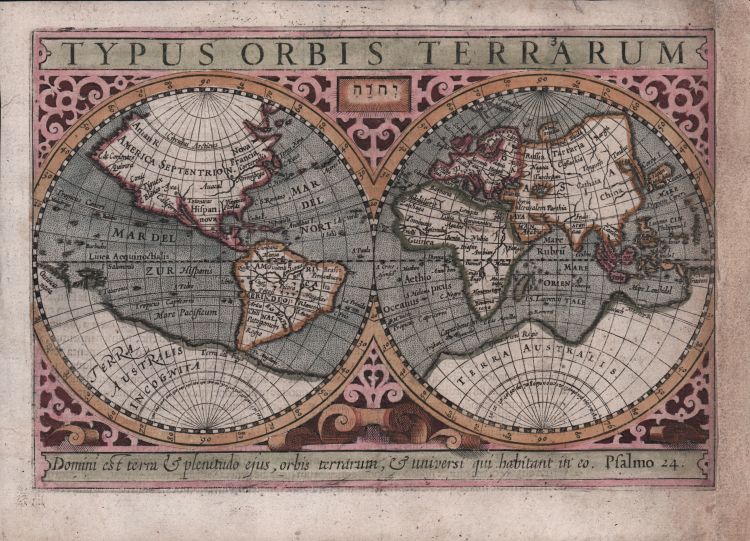




| Reference: | S48068 |
| Author | Jodocus HONDIUS |
| Year: | 1607 ca. |
| Zone: | The World |
| Printed: | Amsterdam |
| Measures: | 200 x 140 mm |



| Reference: | S48068 |
| Author | Jodocus HONDIUS |
| Year: | 1607 ca. |
| Zone: | The World |
| Printed: | Amsterdam |
| Measures: | 200 x 140 mm |
A miniature map of the World taken from Atlas minor, by Jodocus Hondius, Latin edition.
Mercator's Atlas Minor was conceived by Jodocus Hondius in 1607 as a reduced-sized edition of the popular folio-sized Mercator Atlas. The Atlas Minor was intended to be larger than a pocket atlas, yet smaller than the folio atlas, and were priced accordingly to reach a new market.
There were three different editions of the Atlas Minor published by different authors, each with a new set of copperplates. Jodocus Hondius published the first edition from 1607-1621, and subsequently sold the copperplates to parties in England between 1621-1625, after which an English edition was published using many of the original plates in 1635-39. Johannes Jansson wanted to compete in the small atlas market as well, and had new copperplates engraved by Pieter van den Keere and Abraham Goos for his own edition published in multiple languages between 1628-51. The third and final edition was published by Jan Evertsz. Cloppenburch (or Cloppenburg) between 1630-1734 (some without text), with new maps engraved primarily by Pieter van den Keere.
"Shortly after the publication of the big folio-atlases the need was apparently felt for a smaller-sized atlas, one that would be handier, and, above all, cheaper, so that a larger public might have access to the use of maps. The publication of the Atlas Minor appeared to be a great success for Hondius; the first Latin edition was in great demand. The copperplates of the first atlases minor were most almost certainly engraved by Jodocus Hondius himself. After 1621, the copperplates of the Atlas Minor were sold to a London editor. Firstly, they appeared in Purchas his Pilgrinies, printed in 1625 by William Stansby for Henry Featherstone. Next they were used for the translation of the Mercator-atlas, printed in small folio under the title Historia mundi, or Mercators atlas, by Thomas Cotes for Michael Sparke and Samuel Cartwight in 1635". (cf. Koeman II Me 191).
"As with the Theatrum of Abraham Ortelius, Jodocus Hondius planned a reduced size version of Gerard Mercator's folio atlas. Just one year after his first edition he published his Latin text Atlas Minor in collaboration with Jan Jansz. and Cormelis Claesz. The arrangement between these three is not understood clearly but Hondius is believed to have been the owner of the copperplates. Cartographically this is taken directly from the folio maps by Hondius in 1606 [..]. with the inevitable loss of detail due to the reduction” (cf. Burden, The Mapping of North America, 153).
"It consists of twin hemispheres after Mercator with the title at the top and Hondius' favorite quotation from the Psalms at the bottom. Terra Australis Incognita fills the Southern Hemisphere and connects to New Guinea in the region of Australia. Mercator's Northwest Passage and interesting polar islands have been replaced with a non-descript landmass. The eastern coast of Asia has been revised to include a Korean Peninsula. The engraving is neat and clear with stippled sea" (cfr. Shirley, The Mapping of the World, 259).
Copperlate with fine later hand colour, margin added at right edge, otherwise very good condition.
Bibliografia
Shirley, The Mapping of the World, 259).
Jodocus HONDIUS (Amsterdam 1563 - 1612)
|
Jodocus Hondius (1563-1612) was a foremost map engraver of his day; he worked for many Dutch publishers, and was employed by the English map and print-sellers, Sudbury and Humble, to engrave the maps for John Speed’s The Theatre of The Empire of Great Britaine, published in 1612. In 1604, Hondius bought the copperplates of Mercator’s Atlas at the auction of Gerard Jr.’s effects. He added another forty maps, including new maps of the Continents and important regional maps of the Americas, before publishing a new edition of the Atlas, in 1606, in competition with Ortelius’ Theatrum. As many of the maps were more up-to-date, the Mercator-Hondius Atlas effectively superseded Ortelius’ Theatrum. On his death in 1612 his widow, Coletta van den Keere continued the business; from 1619 onwards their son Henry (II) (1597-1651) took over. From 1633 publication was carried on in co-operation with Jan Jansson Jr., Henry’s brother-in-law.
|
Jodocus HONDIUS (Amsterdam 1563 - 1612)
|
Jodocus Hondius (1563-1612) was a foremost map engraver of his day; he worked for many Dutch publishers, and was employed by the English map and print-sellers, Sudbury and Humble, to engrave the maps for John Speed’s The Theatre of The Empire of Great Britaine, published in 1612. In 1604, Hondius bought the copperplates of Mercator’s Atlas at the auction of Gerard Jr.’s effects. He added another forty maps, including new maps of the Continents and important regional maps of the Americas, before publishing a new edition of the Atlas, in 1606, in competition with Ortelius’ Theatrum. As many of the maps were more up-to-date, the Mercator-Hondius Atlas effectively superseded Ortelius’ Theatrum. On his death in 1612 his widow, Coletta van den Keere continued the business; from 1619 onwards their son Henry (II) (1597-1651) took over. From 1633 publication was carried on in co-operation with Jan Jansson Jr., Henry’s brother-in-law.
|